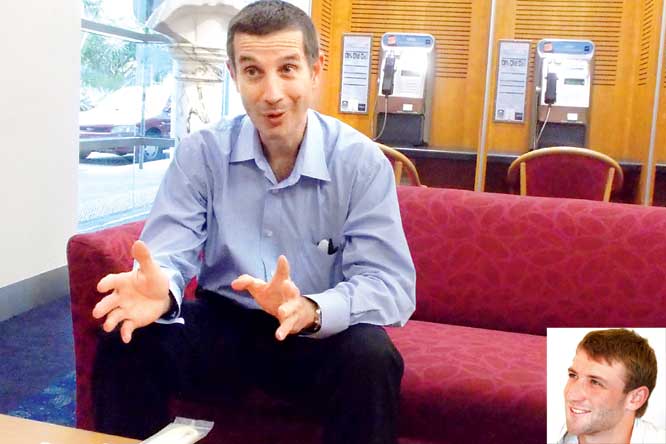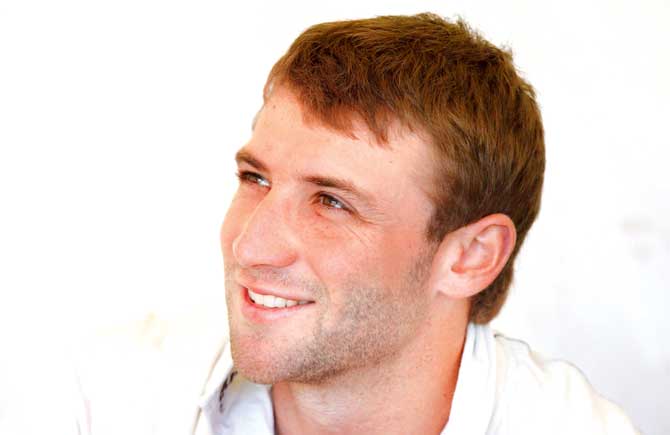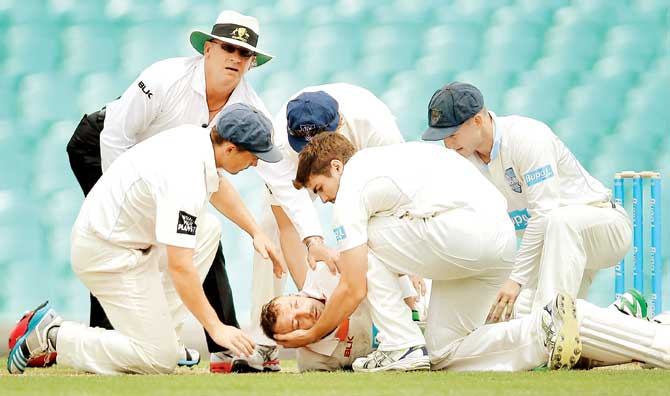Dr Tony Grabs, who attended to Hughes in hospital when he was struck by a Sean Abbott bouncer at Sydney exactly four months ago, talks to mid-day

Sydney: Everyone talks about the pressures of international cricket and playing in front of packed houses. Professional cricketers have to be used to that. But what about a doctor, who is unexpectedly thrust into the most important position in world cricket?
Dr Tony Grabs, head of Trauma and Emergency Department at the St Vincent's Hospital in Sydney yesterday. Pic/Ashwin Ferro
Dr Tony Grabs, Head of Trauma and Emergency Department at the St Vincent's Hospital here and his team, who performed their 100-minute operation on Phillip Hughes, who was hit by a bouncer from Sean Abbott during a Sheffield Shield match on November 25 last year, were put under exactly this pressure.
ADVERTISEMENT
In an exclusive interview with mid-day, Dr Grabs (52) recalls what happened in the 48 hours since Hughes was rushed post-lunch into the city's premier hospital's emergency intensive care unit on that terrible Tuesday exactly four months ago.
He says that even as the entire cricketing world prayed for the 25-year-old batsman's recovery, his team of doctors knew the very moment they saw Hughes in hospital that there was very little hope given the extent of the injury.
Excerpts:
Do you think cricket is a dangerous sport?
Cricket has got the lowest rate of injuries in my experience of almost 20 years at this hospital. And there are numerous cricket fields in and around the Sydney Cricket Ground with many people — adults and kids — playing the game. We get a lot of injuries from soccer or Australian rules football or rugby because these are impact sports, so fractures, joint dislocations and major bruises are common, but none in cricket. There have been cases of body blows in cricket right from the Bodyline series in as early as the 1930s, and following that protective hats and helmets were the logical way forward. Close-in fielders wear helmets and that's the right thing to do. Head injuries must be avoided at all costs.
Phil Hughes
What are your thoughts on bouncers in cricket?
I think they are part and parcel of the game. But personally, my heart skips a beat every time I watch a bouncer directed straight at a batsman's head. The other day the Pakistanis (Wahab Riaz) were bowling some fast bouncers against Australia (in the World Cup quarter-finals) and each time I saw the ball pass so close to a batsman, I was a bit uncomfortable. A cricket ball hurled at 140 kmph is a dangerous weapon.
Are helmets adequate protection from head injuries?
Look, the Hughes incident was a freak and very unique case. But thereafter, the modification of the helmets were discussed and have subsequently been carried out too, especially from the back, covering the lower part of the head around the neck area. I think that's perfectly fine. I'm not a batsman, but I've heard that there have been some limitations of movement of the head for batsmen with the new helmets. But, the movement is not very restrictive and it's a small price to pay to protect your head and life. But more importantly, helmets should fit correctly. I've noticed in grounds, many a times, a team shares just two or three helmets and these don't fit all batsmen correctly since all heads are not the same obviously. This must be avoided because first of all, a helmet does not ensure zero-head injury. A helmet only prevents the focal contact of the ball on a vulnerable area. For example, the temple area in particular, is very vulnerable because there's a blood vessel that runs up on the inner side of the skull bone, so if you get a fracture there you can have internal bleeding pretty quickly. What a helmet does is it absorbs the contact and spreads it across a larger area of the head reducing the danger. Conversely, when a ball hits the head directly, it's a high-energy impact on a small contact area, so that's dangerous. So, even a helmet cannot stop concussion that can occur on impact.
What was your reaction when you saw Phillip Hughes for the first time in hospital?
I'm a vascular surgeon (surgery that deals with the vascular system comprising arteries and veins) so I could tell that the artery at the base of the skull (neck region, just below the skull) was damaged. I felt very, very sad and in a sense, I also felt a very strong feeling of helplessness looking at the gravity of the injury. As a doctor, I had never encountered such a case ever and none of the doctors I know, had either.
South Australia's Phillip Hughes is attended to by NSW players after being stuck on the head by a Sean Abbott bouncer at the Sydney Cricket Ground on November 25, 2014. Pic/Getty Images
What were the initial moments of Phillip Hughes' admission like?
The most important component of any neurosurgical therapy is the time taken from the occurrence of injury to the time in reaching the operating theatre, and that's the difference between a good outcome and bad one.
In normal emergency cases, time is spent in the initial investigative department, going in for scans and/or getting in surgeons, but in this case, we had pre-notification that such an incident had occurred on the cricket field. So, my team was ready and everyone was available. We went straight to the scanner and from there he was immediately rushed into intensive care. That's where I saw him and at first glance we realised that there was not much we could do as it was a very difficult situation. He was not dead, but the sheer extent of the injury gave us all a heart-sinking feeling.
How did your team handle the family, crowds and media?
Our team was very professional because we do see a lot of awful things happening around us with emergencies coming in all the time. But this was different and completely unexpected in nature. We have two teams of social workers, who are on call 24 hours — one from the nursing department and one in the intensive care department and their job is to primarily counsel the patient's close family and relatives. There was chaos around the entrance of the hospital but everyone was kept at bay as the family's privacy and protection was our priority. It was a story of significant interest for the media, but they showed good restraint given the sensitivity of the situation.
And what about the cricketers?
Absolutely no one was allowed to come in, and I met the cricketers beginning with Michael Clarke and the others only two days later, after Hughes had passed away.
How long did the operation last? Was there any hope at all after surgery?
The operation lasted for an hour and 40 minutes. I was in and out of the theatre repeatedly and was following the entire procedure on the scanners outside the theatre whenever I stepped out. But the prognosis was clear right from the start. We could feel it. We felt that it probably wouldn't help.
So when were you certain that Hughes had passed away?
On the second day (November 27). We completed some formal tests and found that he was brain dead. There were no reflexes in the body. We have to wait for 48 hours before taking a call in such cases because we have to make sure there are no drugs influencing the individual. You look at the pupils and there are also a series of subtle tests that we do on scans looking at the blood flow in the brain. Some of the scans can tell us that there is no blood flowing in the brain and the reason for this could be due to the pressure on the brain where swelling may have occurred.
Who relayed the news to the family and what was their initial reaction?
I didn't do it, one of our doctors from the operation theatre did it. It's a very tricky situation because you have to constantly keep in mind the sensitivity of the issue and the grace that needs to be maintained right through. The family was in deep shock but they were prepared for the worst. Cricket Australia decided that they would announce the news to the outside world. To be honest, I went back and looked at the footage (of the match) a couple of times and the very instant I saw him stumbling after the impact of the bouncer, I could tell that something was terribly wrong. As a doctor I felt right then and there that he was not going to do very well after that. And the fact is that his heart did stop at the ground itself and he had to be given CPR (Cardiopulmonary Resuscitation) on the sidelines. It was a remarkable effort from the people at the ground to get him to the hospital in the condition that they did.
How did the players react?
They were in disbelief. I think everyone else outside was in disbelief. I have a wife and kids and they too could not believe it. But I was very impressed with the way the players conducted themselves not only in the immediate aftermath, but even when they went out to play and reached various milestones and dedicated it to Hughes.
But can't a brain dead person still be kept alive artificially?
Initially it's not possible to tell if a person is brain dead. We could not assess if Hughes was brain dead on the very first day without going through various tests and scans. We don't declare someone brain dead first up because we always have hope for improvement. So, we give the patient a chance to get better by providing maximum therapy which includes drugs and other methods of treatment. Our machines keep him in the best position. A brain dead person can be kept alive on machines for long, but it's not a satisfactory thing to do because the patient cannot move at all and so they get pressure areas, and their nutrition is poor anyway, so things can only get worse. It was a joint decision between the doctors and the family in this context.
Is there truth in the reports that there was a delay in the ambulance reaching the spot?
There may have been some slight delays, but there were doctors on the field, who happened to do exactly what an ambulance would have done. So, there was no delay in treatment to the patient.
Finally, are you following this World Cup closely and who do you think will win tomorrow's semi-final?
I'm obviously unable to watch all the matches as I'm on medical call most of the time, but I did watch a few games on TV. I've watched India play and I think Australia might just end up being in trouble against the Indians at the SCG.
 Subscribe today by clicking the link and stay updated with the latest news!" Click here!
Subscribe today by clicking the link and stay updated with the latest news!" Click here!







